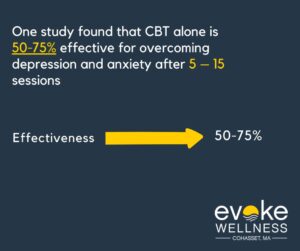You have likely experienced negative or unhelpful thoughts from time to time. These distorted thinking patterns can contribute to emotional distress and affect your mental health. Cognitive restructuring is an evidence-based technique used in many modern psychotherapy approaches to identify and replace maladaptive thoughts with more balanced perspectives. With practice, cognitive restructuring can help empower you to take control of your thought patterns and improve your overall well-being. Call us at (617) 917-3485 today or reach out online to begin your wellness journey.
What Is Cognitive Restructuring?
Cognitive restructuring is a core component of cognitive-behavioral therapy (CBT) and other evidence-based psychotherapies. It involves identifying and changing irrational or maladaptive thought patterns that can contribute to psychological distress. Some research shows that CBT is the most effective form of treatment for those coping with depression and anxiety. One study found that CBT alone is 50-75% effective for overcoming depression and anxiety after 5 – 15 sessions.
A Closer Look
This therapeutic technique aims to replace negative thought patterns with more balanced, realistic perspectives. Through cognitive restructuring, individuals learn to:
- Recognize unhelpful thought patterns and cognitive distortions
- Challenge irrational beliefs by examining evidence
- Adopt more positive, adaptive ways of thinking
Benefits for Mental Health
Numerous studies highlight the mental health benefits of cognitive restructuring. By modifying deep-rooted negative thought cycles, it can help alleviate conditions like:
- Depression and low self-esteem
- Anxiety disorders and phobias
- Trauma responses like Post-Traumatic Stress Disorder (PTSD)
- Anger management issues
Overall, cognitive restructuring empowers people to manage unhealthy thinking that fuels emotional struggles. It’s a key tool for developing resilience and wellbeing.
Techniques Used in Cognitive Restructuring
Identifying Negative Thoughts
A core technique involves recognizing and labeling distorted thinking patterns. This heightens self-awareness around irrational beliefs fueling negative emotions. Common patterns include all-or-nothing thinking, catastrophizing, and emotional reasoning.
Challenging Negative Thoughts
Once identified, patients learn to evaluate and challenge their negative automatic thoughts. They gather evidence for and against the thought, consider alternative perspectives, and replace it with a more balanced, rational view.
Behavioral Experiments
Putting newly restructured thoughts to the test can further reinforce cognitive change. Behavioral experiments allow patients to approach anxiety-provoking situations and observe whether their catastrophic predictions come true.
Developing a Rational Self-Statement
Throughout this process, patients craft personal coping statements that encapsulate their desired, more positive outlook. Reciting these rational self-statements during distressing situations helps restructure thinking patterns over time.
Cognitive Restructuring as a Key Component of Cognitive-Behavioral Therapy (CBT)
The Role of Thoughts
Cognitive restructuring is a core technique in CBT that helps individuals identify and modify irrational or distorted thinking patterns. Our thoughts significantly influence our emotions and behaviors. Negative thought patterns can perpetuate mental health issues like anxiety and depression.
Challenging Cognitive Distortions
Through cognitive restructuring, individuals learn to recognize cognitive distortions – inaccurate ways of perceiving reality. Common distortions include overgeneralization, catastrophizing, and negative filtering. By challenging these distortions with evidence and rational self-talk, individuals can develop more balanced perspectives.
Promoting Lasting Change
Cognitive restructuring equips individuals with skills to navigate difficult situations and manage emotions more effectively. As they practice restructuring their thoughts, they can break free from negative thought cycles and cultivate healthier thinking habits. This empowers them to make positive changes that extend beyond therapy sessions.
How Cognitive Restructuring Helps Treat Mental Health Issues
Challenging Negative Thoughts
Cognitive restructuring teaches you to identify and challenge irrational or negative thoughts that contribute to mental health issues like anxiety or depression. By replacing distorted thinking patterns with more balanced perspectives, you can reduce psychological distress.
Building Healthier Beliefs
This therapeutic technique helps reshape deeply held core beliefs that fuel harmful thought cycles. Over time, cognitive restructuring guides you to adopt more realistic and positive mindsets about yourself, others, and the world around you.
Part of Evidence-Based Therapies
Cognitive restructuring is a key component of empirically supported treatments like cognitive-behavioral therapy (CBT) and dialectical behavior therapy (DBT). These gold-standard psychotherapies effectively treat a wide range of mental health conditions through cognitive reframing strategies.
Steps to Implement Cognitive Restructuring
Identify Negative Thoughts
The first step is to become aware of your negative thought patterns. Pay attention to the automatic thoughts that pop into your mind, especially those related to stressful situations. These distorted thoughts often take the form of overgeneralizations, catastrophizing, or negative self-talk.
Challenge the Thoughts
Once you’ve identified the negative thoughts, question their validity. Are these thoughts based on facts or assumptions? Look for evidence that contradicts the negative thought. Challenging irrational beliefs can help reshape them into more balanced, realistic perspectives.
Replace with Positive Alternatives
After challenging the negative thought, consciously replace it with a more positive, rational alternative. This takes practice, but over time, positive self-talk can become more automatic. Visualizing a stop sign when you notice negative thoughts can reinforce replacing them.
Monitor Progress
Keep track of your progress by journaling your negative thoughts and positive replacements. This allows you to review your cognitive restructuring efforts and reinforce the new, healthier thinking patterns you’re building. Celebrate small wins along the way.
Benefits of Cognitive Restructuring
Improves Mental Health
Cognitive restructuring helps reshape negative thought patterns into more positive ones. This evidence-based technique is a core component of cognitive behavioral therapy (CBT) and other psychotherapies. It empowers individuals to challenge irrational beliefs fueling anxiety, depression, and other mental health issues.
Enhances Daily Functioning
As distorted thoughts diminish through cognitive restructuring, daily functioning improves. Individuals can better manage stress, regulate emotions, and maintain healthy relationships. This boosts overall well-being and quality of life.
Supports Recovery
For those in dual diagnosis treatment programs addressing co-occurring mental health and substance use disorders, cognitive restructuring fortifies coping skills. By reframing thoughts driving addictive behaviors, lasting recovery becomes more attainable.
Limitations of Cognitive Restructuring
While cognitive restructuring is an effective technique, it has some limitations worth considering.
Takes Consistent Effort
Cognitive restructuring requires regular practice to reshape ingrained thought patterns. It demands ongoing commitment and diligence from the individual. Without this dedication, old habits can easily resurface.
Not a Quick Fix
Cognitive Restructuring: A Key Component of Evidence-Based Mental Health Treatments
Results from cognitive restructuring are rarely immediate. It’s a gradual process of recognizing distorted thoughts and replacing them with more balanced perspectives. Patience and persistence are vital.
Difficulty with Deeply Rooted Beliefs
Profoundly entrenched core beliefs about oneself or the world can be challenging to modify through cognitive restructuring alone. Additional therapeutic methods may be needed in such cases.
Guidance Recommended
While self-help cognitive restructuring books exist, undertaking this process alone can be difficult initially. Working with a qualified therapist is generally advisable, especially for complex cases. One on one or group therapy may be beneficial as well as the aforementioned treatment options.
Cognitive Restructuring FAQs
What is cognitive restructuring?
Cognitive restructuring is a therapeutic technique used to identify and modify irrational or maladaptive thoughts, beliefs and cognitive distortions. It helps replace negative thought patterns with more positive, realistic perspectives.
Who can benefit from it?
Anyone struggling with anxiety, depression, phobias, eating disorders or other mental health issues driven by negative thought cycles can potentially benefit. It is a key component of cognitive-behavioral therapy (CBT). It can also help those in PTSD treatment programs who may be struggling with negative memories associated with PTSD.
How does it work?
Through cognitive restructuring, individuals learn to recognize unhelpful thought patterns and develop skills to reframe them into more balanced, rational ways of thinking. This disrupts the cycle of negative emotions fueled by distorted beliefs.
Is it effective?
Yes, extensive research supports cognitive restructuring as an effective treatment approach when implemented correctly. A meta-analysis found it produced significant improvements across various psychological disorders.
Conclusion
In closing, cognitive restructuring has proven to be a vital element of evidence-based mental health treatments. By learning to identify and challenge distorted thinking patterns, you can begin to change your perspectives and reactions to life’s challenges. Seek out a licensed therapist trained in CBT or similar modalities to help guide you through this process. Commit to doing the work between sessions and you’ll start to notice improvements in your mood, outlook and relationships. With practice, cognitive restructuring can equip you with skills to better manage stress, anxiety, depression and more. You have the power to reshape your thoughts and take control of your mental health.
Begin Your Journey with Evoke Wellness at Cohasset
If you or a loved one is considering treatment, Evoke Wellness at Cohasset invites you to contact us. Our compassionate team is ready to answer your questions, discuss your needs, and help you take the first steps toward recovery. In Cohasset, you’ll find more than just a treatment program – you’ll discover a community dedicated to your wellness and success. Together, let’s embrace the journey to recovery and the promise of a new beginning. Call us at (617) 917-3485 today or reach out online.





